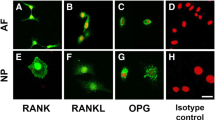Abstract
Background
The intervertebral disc has been reported to be an immunologically privileged environment, possibly mediated by Fas ligand (FasL) expression. On the other hand, recent studies have shown the infiltration of host immune cells into the degenerated disc, which may indicate the failure of the immune-privilege feature of the disc with degeneration. However, the relationship between FasL expression and disc degeneration is still unclear. Therefore, the purpose of this study was to clarify the relationship between FasL expression and disc degeneration.
Methods
Ten human degenerated disc specimens were obtained from spondylolisthesis patients and ten nondegenerated discs from idiopathic scoliosis patients during surgical procedures. Immunohistochemical staining was performed to determine the presence of FasL in cross-sections of those discs. Parts of the disc tissues were used to examine FasL expression quantitatively with Western blot analysis. To examine whether the change in FasL expression was influenced by aging, an animal study comparing the discs from young and old rats were performed using magnetic resonance imaging (MRI) and real-time polymerase chain reaction (PCR) assessment.
Results
Nucleus pulposus cells showed strong positive staining for FasL in all specimens examined. Quantitative examination demonstrated a significant decrease in FasL expression in the degenerated group compared with the nondegenerated group (average 67.6%, P<0.05). MRI showed no significant differences in the grade of disc degeneration between young and old rats, and also no significant difference in FasL mRNA in real-time PCR assay.
Conclusions
The current results indicate that FasL and its potential mechanism of immunological privilege could influence the protection of the intervertebral disc against degeneration.
Similar content being viewed by others
References
Nishida K, Kang JD, Gilbertson LG, Moon SH, Suh JK, Vogt MT, et al. Modulation of the biologic activity of the rabbit intervertebral disc by gene therapy: an in vivo study of adenovirus-mediated transfer of the human transforming growth factor beta 1 encoding gene. Spine 1999;24:2419–2425.
Nishida K, Kang JD, Suh JK, Robbins PD, Evans CH, Gilbertson LG. Adenovirus-mediated gene transfer to nucleus pulposus cells: implications for the treatment of intervertebral disc degeneration. Spine 1998;23:2437–2442.
Bobechko WP, Hirsch C. Auto-immune response to nucleus pulposus in the rabbit. J Bone Joint Surg Br 1965;147:574–580.
Gertzbein SD, Tait JH, Devlin SR. The stimulation of lymphocytes by nucleus pulposus in patients with degenerative disk disease of the lumbar spine. Clin Orthop 1977;1123:149–154.
McCarron RF, Wimpee MW, Hudkins PG, Laros GS. The inflammatory effect of nucleus pulposus. A possible element in the pathogenesis of low-back pain. Spine 1987;112:760–764.
Olmarker K, Blomquist J, Strömberg J, Nannmark U, Thomsen P, Rydevik B. Inflammatogenic properties of nucleus pulposus. Spine 1995;120:665–669.
Satoh K, Konno S, Nishiyama K, Olmarker K, Kikuchi S. Presence and distribution of antigen-antibody complexes in the herniated nucleus pulposus. Spine 1999;124:1980–1984.
Griffith TS, Brunner T, Fletcher SM, Green DR, Ferguson TA. Fas ligand-induced apoptosis as a mechanism of immune privilege. Science 1995;270:1189–1192.
Bellgrau D, Gold D, Selawry H, Moore J, Franzusoff A, Duke RC. A role for CD95 ligand in preventing graft rejection. Nature 1995;377:630–632.
Bechmann I, Mor G, Nilsen J, Eliza M, Nitsch R, Naftolin F. FasL (CD95L, Apo1L) is expressed in the normal rat and human brain: evidence for the existence of an immunological brain barrier. GLIA 1999;27:62–74.
Lee HO, Ferguson TA. Biology of FasL. Cytokine Growth Factor Rev 2003;14:325–335.
Takada T, Nishida K, Doita M, Kurosaka M. Fas ligand exists on intervertebral disc cells: a potential molecular mechanism for immune privilege of the disc. Spine 2002;27:1526–1530.
Inui Y, Nishida K, Doita M, Takada T, Miyamoto H, Yoshiya S, et al. Fas-ligand expression on nucleus pulposus begins in developing embryo. Spine 2004;29:2365–2369.
Park JB, Charg H, Kim KW. Expression of Fas ligand and apoptosis of disc cells in herniated lumbar disc tissue. Spine 2001; 26:618–621.
Park JB, Lee JK, Park SJ, Kim KW, Riew KD. Mitochondrial involvement in Fas-mediated apoptosis of human lumbar disc cells. J Bone Joint Surg Am 2005;87:1338–1342.
Chen B, Fellenberg J, Wang H, Carstens C, Richter W. Occurrence and regional distribution of apoptosis in scoliotic discs. Spine 2005;30:519–524.
Peng B, Wu W, Hou S, Li P, Zhang C, Yang Y. The pathogenesis of discogenic low back pain. J Bone Joint Surg Br 2005;87:62–67.
Peng B, Hao J, Hou S, Wu W, Jiang D, Fu X, et al. Possible pathogenesis of painful intervertebral disc degeneration. Spine 2006;31:560–566.
Pfirrmann CW, Metzdorf A, Zanetti M, Hodler J, Boos N. Magnetic resonance classification of lumbar intervertebral disc degeneration. Spine 2001;26:1873–1878.
Lotz JC. Animal models of intervertebral disc degeneration: lessons learned. Spine 2004;23:2742–2750.
Gruber HE, Johnson T, Norton HJ, Hanley EN Jr. The sand rat model for disc degeneration: radiologic characterization of agerelated changes. Cross-sectional and prospective analysis. Spine 2002;27:230–234.
Kauppila LI. Ingrowth of blood vessels in disc degeneration: angiographic and histological studies of cadaveric spines. J Bone Joint Surg Am 1995;77:26–31.
Freemont AJ, Watkins A, Maitre CL, Baird P, Jeziorska M, Knight MT, et al. Nerve growth factor expression and innervation of the painful intervertebral disc. J Pathol 2002;197:286–292.
Freemont AJ, Peacock TE, Goupille P, Hoyland JA, O’Brien J, Jayson MI. Nerve ingrowth into the diseased intervertebral disc in chronic back pain. Lancet 1997;350:178–181.
Freemont AJ, Watkins A, Maitre CL, Jeziorska M, Hoyland JA. Current understanding of cellular and molecular events in intervertebral disc degeneration: implications for therapy. J Pathol 2002;196:374–379.
Kaplan HJ, Leibole MA, Tezel T, Ferguson TA. Fas ligand (CD95 ligand) controls angiogenesis beneath the retina. Nat Med 1999; 5:292–297.
Barreiro R, Schadlu R, Herndon J, Kaplan HJ, Ferguson TA. The role of Fas-FasL in the development and treatment of ischemic retinopathy. Invest Ophthalmol Vis Sci 2003;44:282–286.
Davies MH, Eubanks JP, Powers MR. Increased retinal neovascularization in Fas ligand-deficient mice. Invest Ophthalmol Vis Sci 2003;44:3202–3210.
Author information
Authors and Affiliations
About this article
Cite this article
Kaneyama, S., Nishida, K., Takada, T. et al. Fas ligand expression on human nucleus pulposus cells decreases with disc degeneration processes. J Orthop Sci 13, 130–135 (2008). https://doi.org/10.1007/s00776-007-1204-4
Received:
Accepted:
Published:
Issue Date:
DOI: https://doi.org/10.1007/s00776-007-1204-4




